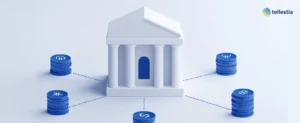
The payment landscape is evolving faster than ever. Legacy systems can no longer keep pace with new customer expectations, regulatory mandates, and digital ecosystems. As FedNow, SWIFT ISO 20022, RTP, and compliance frameworks like PSD2 reshape the future, banks that act now are gaining the edge.
In this blog, we spotlight five real-world client journeys. Each story reflects a rising trend and how Tellestia helped banks adapt, comply, and lead—turning complex change into competitive advantage.
The Trend: ISO 20022 Imperative and the API Ecosystem Shift
Banks globally are facing growing complexity in processing customer-initiated payments. The problem isn’t just volume—it’s format fragmentation. Payment instructions still come in varied, non-standard formats: JSON from mobile apps, EDI 820 from corporate ERPs, XML from third-party gateways, and proprietary flat files from legacy systems. This lack of consistency leads to failed transactions, compliance gaps, and operational inefficiencies.
At the same time, the world’s major payment systems—including Fedwire, CHIPS, SWIFT, SEPA, and FedNow—are converging on a common messaging standard: ISO 20022. Unlike older formats, ISO 20022 provides structured, rich, and extensible data, making payments more transparent, faster to process, and easier to reconcile. In fact, ISO 20022 is projected to handle 80% of global high-value transactions by 2025.
But here's where many banks stumble: the move to ISO 20022 is often treated as a compliance checkbox rather than a strategic opportunity. When done right, migrating to ISO 20022 unlocks new possibilities:
- Real-time validation and STP (Straight Through Processing)
- Smarter fraud detection using rich message fields
- Enhanced interoperability with open banking APIs and fintech platforms
To make the most of this shift, banks must do more than format conversion—they need an intelligent orchestration layer that can normalize, enrich, and route payment messages across systems, in real-time.
The Tellestia Story: How We Helped a Mid-Sized U.S. Bank Future-Proof Its Payments
One regional bank in the U.S. was struggling with precisely this fragmentation. Corporate treasury clients sent payments via EDI 820. The bank’s online platform emitted JSON. Internal batch systems relied on XML. Payment failures, reconciliation delays, and manual interventions were rising—costing time and customer trust.
The bank selected Finastra’s Payments To Go as a modernization anchor, but needed a robust solution to unify and standardize all incoming payments.
That’s where Tellestia stepped in.
We designed and implemented a centralized Payment Integration Hub using a lightweight, API-first framework. The hub:
- Translated incoming messages (EDI, JSON, XML) into ISO 20022
- Validated them against payment rail requirements (Fedwire, FedNow, RTP)
- Applied real-time business rules (limit checks, compliance checks)
- Routed payments through Finastra Payments To Go using enriched ISO 20022 messages
Impact Delivered:
- 70% reduction in manual payment exception handling
- 3x faster onboarding of corporate payment partners
- Foundation ready for open banking use cases and API monetization
Case 2: Standardizing Cross-Border Payments with SWIFT MT to ISO 20022 Migration
The Trend: Why Cross-Border Payments Are Undergoing a Fundamental Overhaul
Cross-border payments have long been plagued by high costs, long settlement times, and opaque processing. Much of this friction stems from legacy messaging formats like SWIFT MT, which offer limited data fields, inconsistent structures, and minimal support for compliance enrichment or fraud analytics.
In response, the global banking community—led by SWIFT—is transitioning to ISO 20022 as the new foundation for financial messaging. The CBPR+ (Cross-Border Payments and Reporting Plus) initiative mandates that banks using SWIFT must be ISO 20022-ready, phasing out MT messages by November 2025.
But this isn’t just a compliance deadline. ISO 20022 is the enabler for:
- Rich, structured payment data that helps with regulatory screening (e.g., sanctions, AML)
- Improved interoperability across regions and payment corridors
- Better reconciliation and transparency for end customers
For banks and financial institutions, this is the moment to future-proof their payment infrastructure—not just to stay compliant, but to gain speed, accuracy, and cost advantage in international transfers.
The Tellestia Story: Helping a Global Bank Simplify and Accelerate Cross-Border Messaging
A multinational bank operating in Asia and Europe approached Tellestia with a challenge:
“We need to standardize thousands of SWIFT MT messages across different transaction types—customer payments, institutional transfers, cheques—and bring them into ISO 20022. But we can’t afford downtime or format-related rejections.”
Our team performed a deep message flow assessment across their cross-border transaction systems. The key was not just format transformation but ensuring semantic accuracy—mapping every relevant MT field to ISO 20022 with full context.
We built a central message transformation service that:
- Auto-identified and categorized incoming MT messages by transaction type
- Translated and enriched them into the correct ISO 20022 messages
- Validated output against SWIFT’s CBPR+ schemas
- Integrated with the bank’s internal compliance and sanctions screening tools
Impact Delivered:
- Achieved 100% CBPR+ readiness across 3 payment systems in under 6 months
- Reduced false positives in sanctions screening by 25% due to richer ISO fields
- Cut message repair effort by 40%, improving back-office productivity
By shifting the focus from just transformation to transformation with intelligence, the bank set the stage for a smoother SWIFT transition and faster onboarding of new corridors.
The Trend: Real-Time Payments Are Becoming the New Normal - Everywhere
Over the past few years, real-time payment (RTP) systems have exploded in popularity. From the U.S. (FedNow, TCH RTP) to India (UPI), Europe (SEPA Instant), and beyond, customers and businesses expect instant fund movement, 24x7. According to industry forecasts, the U.S. real-time payments volume is projected to grow at 30%+ CAGR through 2027, driven by:
- E-commerce and gig economy payouts
- B2B just-in-time supplier payments
- Customer demand for speed and transparency
The real challenge for banks, however, is integration. Legacy Core Banking platforms weren’t built for real-time orchestration. They run in batch. Their settlement processes and fraud checks are asynchronous. To enable instant payments, banks (and the ISVs serving them) must re-architect how the core talks to RTP rails. This is where embedded RTP functionality becomes a differentiator—not just for banks, but also for ISVs with core banking products who serve them.
The Tellestia Story: Enabling a Leading ISV to Power Instant Payments for Global Banks
A prominent Core Banking ISV approached Tellestia with a strategic goal:
“Our core system is being used by dozens of banks worldwide. We need to integrate with both TCH RTP and FedNow so our clients can enable real-time payments. But each bank’s environment is different. We need a scalable, reusable integration layer.”
Tellestia designed and delivered an RTP Adapter Framework that could be reused by multiple bank clients of the ISV. Key features included:
- Prebuilt integration connectors for TCH RTP and FedNow
- API-based orchestration that worked across different bank infrastructures
- Configurable settlement and fraud check layers tailored to each bank
- Real-time acknowledgement and tracking for end-users
We worked alongside the ISV’s product engineering team, offering white-labeled integration accelerators that were rolled out to their customer banks.
Impact Delivered:
- 12+ client banks of the ISV went live with real-time payments within 9 months
- Banks reported a 40% reduction in average payment turnaround times
- The ISV gained a competitive edge in RFPs by offering native RTP compatibility
By embedding real-time capabilities directly into the core platform, our client didn’t just react to market demand—they shaped it.
Case 4: Driving Utility Payment Adoption in Africa through Seamless Integration
The Trend: Digital Utility Payments Are Reshaping Financial Inclusion in Emerging Markets
Across Africa, the rise of mobile wallets and branchless banking is transforming how people access financial services. But one of the fastest-growing and often overlooked opportunities is utility payments—water, electricity, telecom, and municipal services—moving from manual, cash-based transactions to fully digital experiences.
The reason this matters is simple: utility payments are high-frequency, high-volume, and habitual. When banks offer a frictionless way to manage them digitally, they don't just gain transaction volume—they:
- Deepen wallet share with retail customers
- Build trust and engagement through everyday use
- Create upsell opportunities for savings, lending, and micro-insurance
But enabling this isn’t just about launching a mobile app. Banks must integrate in real-time with multiple utility providers, payment processors, and regulatory bodies, all of which operate with different standards and systems. To succeed, banks in emerging markets must create an agile payments integration layer—one that can interface with telcos, government agencies, and fintechs, while ensuring uptime, security, and scalability.
The Tellestia Story: Powering a National Utility Payments Backbone for a Major African Bank
One of the largest banks in West Africa had a vision:
“We want to become the go-to digital channel for paying bills—electricity, telecom, and water. But we don’t have the middleware to manage those integrations efficiently.”
Tellestia partnered with the bank to design and implement a core payments integration layer that could unify disparate payment channels and providers. Our solution included:
- A centralized hub to manage and route utility payment requests
- Real-time API integrations with 20+ utility companies and telcos
- Automated reconciliation and confirmation for both the bank and end customer
- Scalable design to accommodate rural agent networks and mobile apps
Within two quarters of go-live:
- Over 60% of the bank’s retail base adopted digital utility payments
- The platform processed USD $225 million in transactions
- Call center complaints related to utility payments dropped by 55%
This wasn’t just a payments project—it became a national infrastructure enabler. The bank now plays a central role in the country’s financial inclusion drive, leveraging utility payments as a growth engine.
Case 5: Embedding Compliance into Payment Architecture — From PCI DSS to PSD2
The Trend: Why Compliance-First Design Is Becoming a Strategic Advantage
From data breaches to API monetization mandates, the compliance landscape for payment systems is getting more complex—and more critical to business growth.
Global regulations like:
- PCI DSS (for cardholder data security),
- PSD2 (for open banking and customer authentication),
- SCA, GDPR, GLBA and more…
…have moved beyond checkbox certifications. Regulators now expect proactive compliance—architectures that embed security, consent, and customer protection by design.
More importantly, non-compliance is costly:
- Fines running into millions
- Delays in launching new services
- Loss of customer trust
Banks are realizing that a modular, API-first, compliance-aware payments architecture allows them to:
- Launch new services faster
- Partner with third parties confidently
- Reduce the cost of audits and certifications
The Tellestia Story: Making Compliance a Catalyst for Innovation in a Tier-1 Payment Processor
A global payment processor catering to banks and fintechs needed urgent help. Their clients were demanding faster onboarding and stronger fraud protection, but their architecture was rigid—making compliance painful.
Their challenges:
- PCI DSS gaps in tokenization and encryption
- No clear path to enabling PSD2 open APIs
- High cart abandonment due to weak SCA implementation
Tellestia worked with them to overhaul their payments infrastructure. We designed:
- A tokenization service that decouples card data storage from transaction flows
- API security layers for exposing PSD2-compliant services (Account Info, Payment Initiation)
- Context-aware MFA (Multi-Factor Authentication) using behavioral and biometric signals
All powered by microservices and layered encryption, integrated into their existing stack.
Impact Delivered:
- Passed PCI DSS recertification in record time
- Enabled partner banks to meet PSD2 deadlines without new dev work
- Reduced authentication drop-offs by 30%, improving customer conversion
By shifting left on security and compliance, the client turned regulatory pressure into a product advantage—attracting more partners and lowering risk.
Final Thoughts
Across all five use cases, one theme is clear: Payments are becoming the battleground for customer loyalty, speed, and innovation. Whether it’s migrating to ISO 20022, enabling real-time rails, embedding utility flows, or securing data exchange—banks that get their payments architecture right will lead the next wave of digital transformation.
At Tellestia, we specialize in helping financial institutions and fintechs build future-ready payments ecosystems—through intelligent integration, compliance-first design, and scalable transformation models.
If your payments journey needs more than just technology—if it needs a strategic partner who speaks banking—we're ready to help.
Naveen
Director - Client Engagement & Partnership
Naveen is a Director at Tellestia, focused on empowering businesses through innovative tech solutions. He writes about leadership, strategy, and digital transformation.
API-led integration
Banking
digital utility payments
FedNow integration
ISO 20022 migration
payment integration success stories
Payment Modernization
Real-time Payments

























